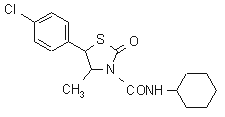Acaricide

NOMENCLATURE
Common name hexythiazox (BSI, draft E-ISO, (m) draft F-ISO)
IUPAC name (4RS,5RS)-5-(4-chlorophenyl)-N-cyclohexyl-4-methyl-2-oxo-1,3-thiazolidine-3-carboxamide
Chemical Abstracts name trans-5-(4-chlorophenyl)-N-cyclohexyl-4-methyl-2-oxo-3-thiazolidinecarboxamide
CAS RN [78587-05-0] Development codes NA-73 (Nippon Soda)
PHYSICAL CHEMISTRY
Mol. wt. 352.9 M.f. C17H21ClN2O2S Form Colourless crystals. M.p. 108.0-108.5 ºC V.p. 0.0034 mPa (20 ºC) KOW logP = 2.53 Henry 2.40 × 10-3 Pa m3 mol-1 (calc.) Solubility In water 0.5 mg/l (20 ºC). In chloroform 1379, xylene 362, methanol 206, acetone 160, acetonitrile 28.6, hexane 4 (all in g/l, 20 ºC). Stability Stable to light, air and heat, and in acidic and alkaline media. Stable to 300 ºC. Aqueous solution in sunlight DT50 16.7 d.
APPLICATIONS
Mode of action Non-systemic acaricide with contact and stomach action. Good translaminar activity. Has ovicidal, larvicidal, and nymphicidal activity. Not active against adults, but eggs laid by treated females are non-viable. Uses Control of eggs and larvae of many phytophagous mites (particularly Panonychus, Tetranychus, and Eotetranychus spp.) on fruit, citrus, vegetables (all at 150-300 g/ha), vines and cotton. Formulation types EC; FU; WP.
ANALYSIS
Product and residue analysis by hplc (M. Tokieda et al., J. Pestic. Sci., 1987, 12, 711).
MAMMALIAN TOXICOLOGY
Reviews FAO/WHO 62, 64 (see part 2 of the Bibliography). Oral Acute oral LD50 for rats and mice >5000 mg/kg. Skin and eye Acute percutaneous LD50 for rats >5000 mg/kg. Mild eye irritant; non-irritating to skin (rabbits). Non-sensitising to skin (guinea pigs). Inhalation LC50 (4 h) for rats >2 mg/l air. NOEL (2 y) for rats 23.1 mg/kg b.w.; (1 y) for dogs 2.87 mg/kg b.w.; (90 d) for rats 70 mg/kg diet. ADI (JMPR) 0.03 mg/kg [1991]. Other Non-teratogenic. Not mutagenic in the Ames assay. Toxicity class WHO (a.i.) III (Table 5); EPA (formulation) IV EC hazard N; R50, R53
ECOTOXICOLOGY
Birds Acute oral LD50 for mallard ducks >2510, Japanese quail >5000 mg/kg. Dietary LC50 (8 d) for mallard ducks and bobwhite quail >5620 mg/kg diet. Fish LC50 (96 h) for rainbow trout >300, bluegill sunfish 11.6 mg/l; (48 h) for carp 3.7 mg/l. Daphnia LC50 (48 h) 1.2 mg/l. Bees Not toxic to bees. LD50 by topical application >200 mg/bee.
ENVIRONMENTAL FATE
Animals The main metabolite in urine and faeces is 5-(4-chlorophenyl)-N- (cis-4- hydroxycyclohexyl)-4-methyl-trans-2-oxothiazolidine-3-carboxamide. Soil/Environment DT50 in clay loam at 15 ºC, 8 d. In soil, undergoes oxidation to the corresponding hydroxy and carbonyl compounds. Koc 6200.
|